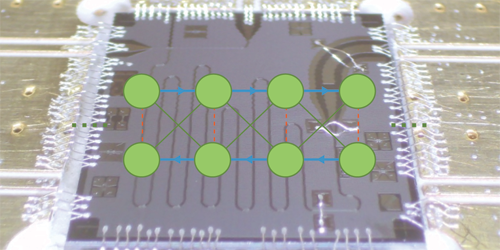Simulating Quantum Particles on a Lattice
A quantum simulator is a limited-use quantum computer: a machine that can be programmed to replicate the behavior of a specific quantum system that is too complex to simulate using classical methods. Because of their comparative simplicity, many researchers believe that quantum simulators could deliver useful applications sooner than universal quantum computers will. With this goal in mind, Christopher Wilson of the University of Waterloo in Canada and colleagues have used a chip-based superconducting cavity to build a quantum simulator that can simulate quantum particles on a lattice [1]. Such particle-lattice systems can be used as models for the behavior of high-temperature superconductors or the particles inside an atomic nucleus.
The superconducting cavity demonstrated by Wilson and colleagues holds microwave radiation of specific frequencies, or modes, which are determined by the cavity’s size. The researchers change the effective size of the cavity by delaying the propagation of photons at one end by a variable interval. When the cavity contains multiple microwave photons, tuning its effective length causes the various cavity modes to interact with each other.
The team used this setup to create a so-called bosonic Creutz ladder—a simple model of particles moving on a lattice of four nodes. In their implementation of the model, Wilson and colleagues engineered the cavity-mode interactions so that each mode of the cavity corresponded to a node on the lattice. They also showed that the quantum simulator can be programmed in situ by introducing microwaves of different frequencies into the cavity. The technique can be scaled up to simulate more complex quantum systems by placing multiple superconducting cavities on the chip.
–Sophia Chen
Sophia Chen is a freelance science writer based in Columbus, Ohio.
References
- J. S. C. Hung et al., “Quantum simulation of the bosonic Creutz ladder with a parametric cavity,” Phys. Rev. Lett. 127, 100503 (2021).




